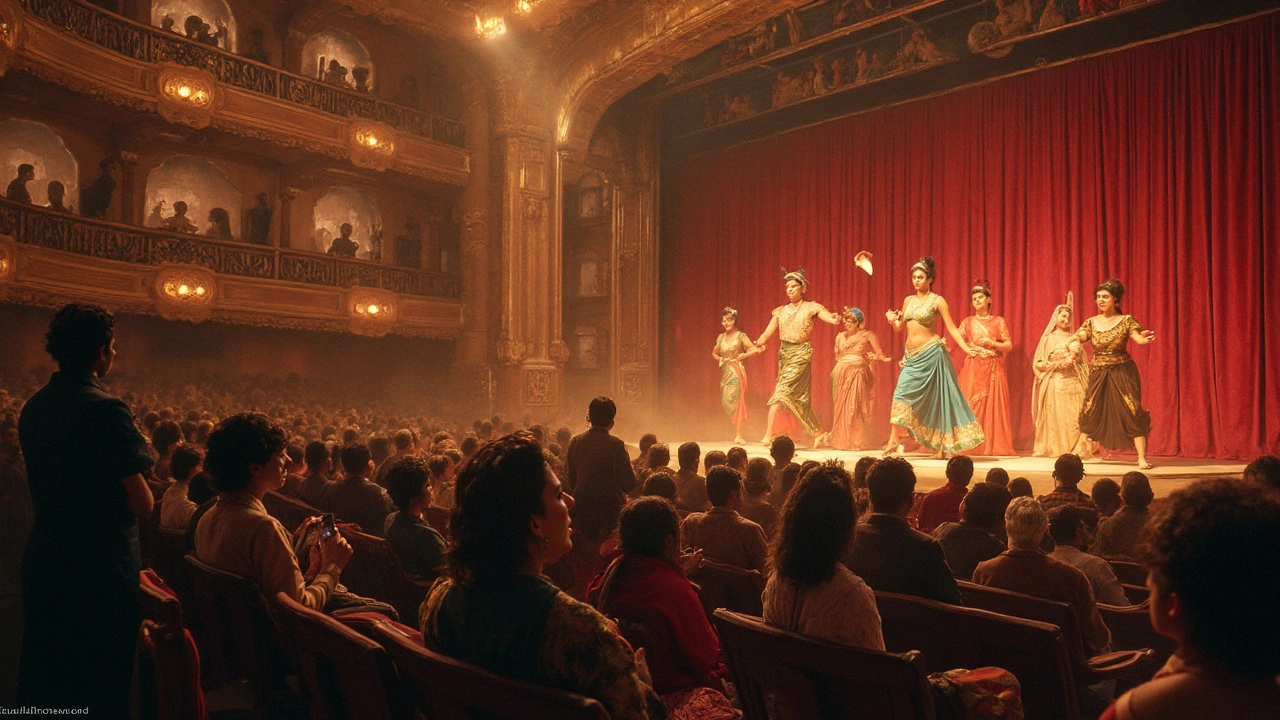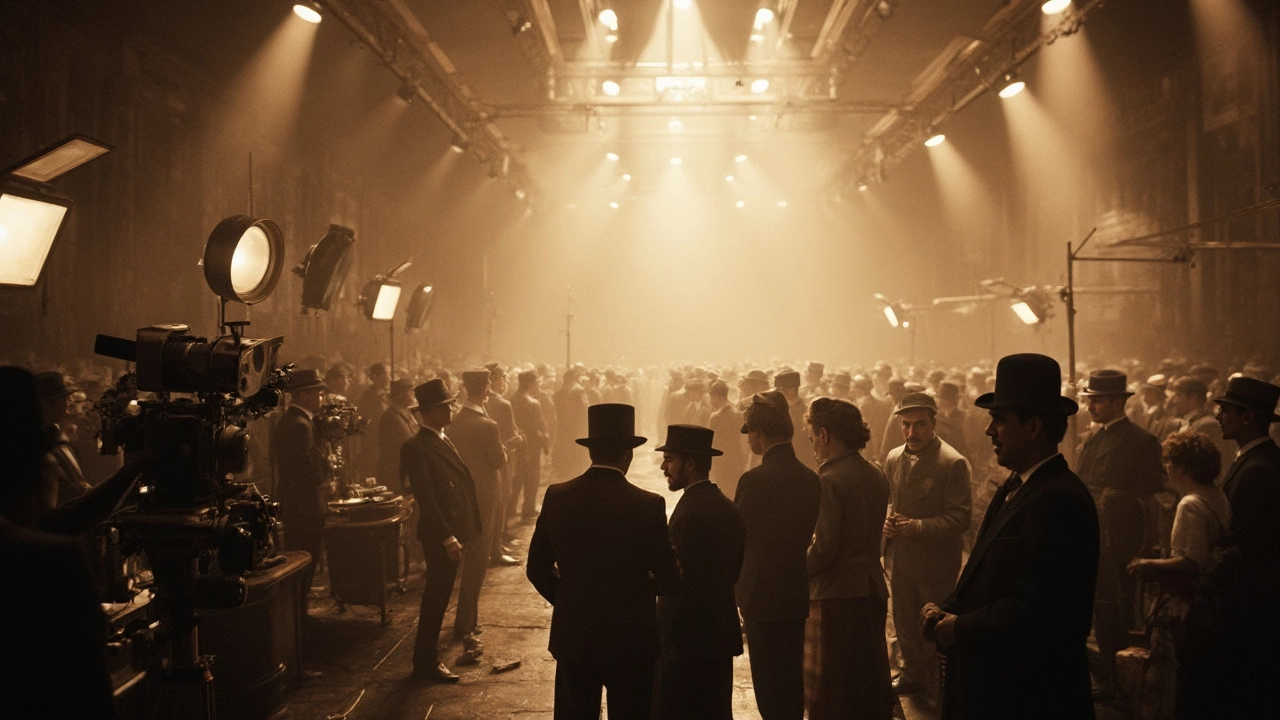Bollywood vs. Hollywood: A Historical First
 Feb, 15 2025
Feb, 15 2025
Did you ever wonder which film industry came first, Bollywood or Hollywood? That's a question with an intriguing backstory! Hollywood's journey began in the early 1900s in Los Angeles. This bustling hub quickly became the movie capital, giving birth to the glamorous industry we know today. With its first film studio emerging around 1911, Hollywood was on the fast track to fame.
At the same time, across the globe, India wasn't far behind. The first full-length Indian feature film, 'Raja Harishchandra,' was released in 1913, marking the beginning of what we now call Bollywood. Dadasaheb Phalke, often hailed as the father of Indian cinema, spearheaded this monumental leap.
What's fascinating is how both these industries evolved together yet developed distinct identities. While Hollywood got known for its diverse genres and tech innovations, Bollywood captured hearts with its enchanting music and dance. Understanding their origins enriches our appreciation of their contributions to global culture.
So, who really came first? Hollywood holds the seniority by a few years, but Bollywood quickly carved its niche, transforming the landscape of global cinema forever. Let's dive deeper into the nuances that set these two giants apart.
The Origins of Cinema
The story of cinema begins with a flickering image back in the 19th century. Imagine a time when seeing a picture come to life seemed like pure magic. The first real steps towards creating movies as we know them involved inventors like Thomas Edison and the Lumière brothers. They took the idea of motion pictures and turned it into something tangible.
The patent for Edison's Kinetoscope, a device for viewing moving pictures, was filed in 1891. Shortly after, in 1895, the Lumière brothers orchestrated the first public film screening with their invention, the Cinématographe. These pioneers set the stage (literally) for what would become Hollywood and, later, Bollywood.
The First Films
Early films were short and silent but enough to leave audiences in awe. The first to capture an audience's imagination was the original classic 'Arrival of a Train at La Ciotat.' Legend has it that viewers jumped out of their seats because they thought the train would burst through the screen! These early screenings were vital in taking cinema from novelty to a full-fledged entertainment industry.
Cinema's evolution was dramatic. From these modest beginnings, the art form quickly spread globally, influencing cultures and storytelling worldwide. By the time World War I rolled around, you'd see cinema popping up in Europe, America, and Asia. These humble beginnings laid the groundwork for both Hollywood and Bollywood to flourish.
The fascinating part? The foundation laid in these early days still shapes our love for movies today. Whether it's the chase sequence, the love story, or the big dramatic ending, these all trace back to the very origins of cinema.
Birth of Hollywood
Hollywood didn't start as the glamorous place it is today. In fact, it was just a sleepy little neighborhood in Los Angeles. The film industry was on the move, looking for a place with good weather, varied landscapes, and, frankly, a bit of distance from Thomas Edison's patent enforcers on the East Coast.
Early Days and Silent Films
Around 1910, film companies like The Biograph Company began migrating to Los Angeles. By 1911, Hollywood saw its first studio, Nestor Film Company, setting up shop. This marked the beginning of the Hollywood we know.
The growth was rapid. By the 1920s, Hollywood had become the epicenter of the movie industry. It was the era of silent films—stars like Charlie Chaplin and Mary Pickford ruled the silver screen, setting the stage for the talkies that would follow.
Golden Age Flourishes
The 1930s and 1940s solidified Hollywood's reputation. We call it the Golden Age, with studios like MGM, Paramount, and Warner Bros dominating. These were the years when the foundations for modern cinema were laid, both in terms of film technique and storytelling.
What's often surprising is how crucial this period was in shaping global entertainment. Genres like musicals, westerns, and comedies flourished, giving rise to legendary filmmakers and unforgettable films.
The Star System
One of the unique aspects of Hollywood was the star system, where studios signed actors to exclusive contracts, creating larger-than-life personalities and iconic films. This system played a huge role in the global reach of American films.
As we look back, it's clear that Hollywood was more than just a collection of film studios; it was—and remains—a symbol of dreams, innovation, and, occasionally, scandal. Understanding its birth and rise gives us insights into the workings of the film industry as we know it today.

Beginnings of Bollywood
Bollywood's origin story is as colorful as the films it produces. It all started in 1913 with the release of 'Raja Harishchandra,' directed by the visionary Dadasaheb Phalke. He was the trailblazer who laid the foundation for what is now one of the most prolific film industries in the world. This silent film not only captivated Indian audiences but also marked a cultural milestone.
Following Phalke's groundbreaking work, the film industry in India expanded rapidly. By the 1930s, with the advent of sound in cinema, films like 'Alam Ara' flooded theaters, bringing songs and dialogue to the screen. Music became an integral part of Indian films, setting Bollywood apart with its unique style.
The Rise of Studios
In the 1930s and 1940s, several film studios like Bombay Talkies and Prabhat Studios popped up, creating a more structured industry. These studios brought in more professional approaches to filmmaking, leading to an increase in both the quality and quantity of films.
World War II and India's struggle for independence also had profound impacts on storytelling within Bollywood. Films during this time began exploring themes of nationalism and freedom, resonating with audiences throughout the country.
Bollywood's Distinct Identity
By the 1950s, Bollywood had begun carving out its niche on the world stage. It became known for its elaborate dance sequences, melodic songs, and dramatic storytelling. The Golden Age of Indian cinema dawned with directors like Raj Kapoor and Guru Dutt leading the pack, creating classics that continue to inspire filmmakers worldwide.
Today, the Mumbai-based industry produces hundreds of films annually, making it one of the highest-output film industries globally. Its influence and evolution continue, from silent black-and-white films to today's vibrant, diverse offerings, highlighting a unique blend of tradition and modernity.
Key Differences and Influences
When you think of Hollywood, you might picture red carpets, mega-blockbusters, and stars with global appeal. In contrast, Bollywood often evokes images of grand musical numbers, vibrant costumes, and stories deeply intertwined with Indian culture. These visual differences reflect deeper variations in style, storytelling, and cultural influence.
Storytelling Styles
Hollywood films tend to focus on diverse genres, from action-packed thrillers and sci-fi adventures to indie dramas. The narrative structures are often precise and follow a three-act format. Bollywood, on the other hand, is known for its melodramatic storytelling with extended plots that incorporate romance, family drama, and moral lessons, often topping three hours of runtime. The integration of song and dance is integral, creating a unique viewing experience.
Cultural Influences
Bollywood's strong cultural roots heavily influence its films. These movies often celebrate Indian traditions, festivals, and familial relationships, making them resonate deeply with their target audience. In contrast, Hollywood's narratives tend to be more globalized, reflecting a broader range of cultural experiences.
Interestingly, both industries have been trading influences over the years. Modern-day Bollywood is increasingly embracing Hollywood-style genres and production techniques, while Hollywood has incorporated many elements of Indian culture and film—think of movies like 'Slumdog Millionaire'.
Production and Techniques
Production styles also vary. Hollywood is known for its technical prowess and groundbreaking special effects. With big budgets and cutting-edge technology, Hollywood often leads in innovation. However, Bollywood has made great strides, with recent hits showcasing impressive editing, CGI, and cinematography despite budget constraints.
Film Statistics
| Industry | Annual Film Output | Global Reach |
|---|---|---|
| Bollywood | Approx. 1,800 films | India, Middle East, Southeast Asia |
| Hollywood | Approx. 600 films | Worldwide |
While Bollywood produces a higher number of films annually compared to Hollywood, Hollywood's reach is much more global, often dominating international box offices.
It's fascinating how these differences not only define each industry but also contribute to their global appeal. Both Bollywood and Hollywood continue to influence each other, creating a dynamic exchange of culture and creativity that's both enriching and exciting to watch.